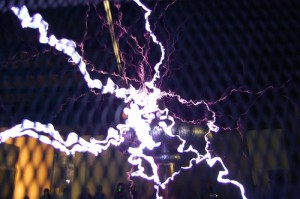 We are a society addicted to gadgets. Many of us would not know what to do without our computers, cell phones, televisions, toasters…you get the idea. Because of this, when we think about the possibility of an EMP or solar storm, one of our first concerns is protecting these precious electronics. But the truth of the matter is, we can live without all these things. We can’t live without food, water and shelter. So please, take the time to get those aspects of preparedness ready first. That being said, if you feel like you are well on your way to being off grid and would like to still be able to play solitaire without cards, even after “it” hits, here are some ideas. (Note: despite all of my research, none of these have been tested in an actual solar storm or EMP attack, and so are not in any way guaranteed.)
We are a society addicted to gadgets. Many of us would not know what to do without our computers, cell phones, televisions, toasters…you get the idea. Because of this, when we think about the possibility of an EMP or solar storm, one of our first concerns is protecting these precious electronics. But the truth of the matter is, we can live without all these things. We can’t live without food, water and shelter. So please, take the time to get those aspects of preparedness ready first. That being said, if you feel like you are well on your way to being off grid and would like to still be able to play solitaire without cards, even after “it” hits, here are some ideas. (Note: despite all of my research, none of these have been tested in an actual solar storm or EMP attack, and so are not in any way guaranteed.)
An EMP and major geomagnetic storm are similar, though not identical. Both can vary in severity, the exact wavelengths experienced, and the effects they would have on your technology. Like lightning, they send super-charged electromagnetic energy through any electrical device which would fry most circuitry in the equipment – including batteries. Unlike lightning, the pulses are very generalized, and so harder to shield against.
So, if there is something you want to still work (your car, your radio, your laptop) after an event like this, what do you do? Here are some ideas to get you started:
Faraday cages
There is a lot of information available online–some good and some not so good. Much of it is contradictory. If you really want to learn more, consider taking a basic electrical wiring class at your local community college. Until then, the basic components of a successful Faraday cage are:
- a continuous circuit of heavy metal
- no antenna to wick charges in
- good grounding
There is much discussion about what types of metal will work. Wire mesh is often suggested, but that may still allow some charges in to wreck havoc on what’s inside. Other sites will proclaim that you can wrap anything in tin foil and it will be saved, although it is probably too thin to protect from anything but the most minor bursts. Your best bet on a budget is to have a nested cage – one container inside another, each layer wrapped in a non-conductive substance like bubble wrap alternated with the conductive substance like foil. However, this type of shielding would be difficult to ground, though some argue that a nested cage does not need grounding.
As for the continuous circuit, any gap at all will open the circuit and destroy its ability to work as a shield. Any metal that extends outside the shield may draw the current in. And of course, everything must be grounded! You can be creative here as long as you follow these guidelines. You can make a cage big or small, depending on what materials you have to work with. For example, wrap your radio in bubble wrap, then place inside a metal safe and ground it with a copper pipe.
The Microwave Faraday
You probably already have a Faraday cage in your house – it is called a microwave. A microwave cooks by bouncing around electromagnetic waves, which need to be contained instead of bouncing around your kitchen. If you can find a free (working or not) microwave on Craig’s List or Freecycle, then you have an instant box for all your electronic goodies. Well, almost. There is still the issue of an antenna, since the cord can grab the electrical currents and bring them in. You will need to remove the cord, and cover with a metal plate to create the complete electrical circuit. Also, find a way to ground it. (In normal operation, it is grounded by plugging it in to a grounded outlet, but obviously this will not solve the problem in an EMP.)
Speaking of microwaves, they are not only a Faraday cage, but provide a great visual for how and why one works. In an interesting YouTube video, someone builds a Faraday cage with Peeps in it and then microwaves them. (No, not REAL chickens! Marshmellow ones! You can come down off the ceiling now!)
As you will notice, the clamps on the wire mesh provide the continuous circuit. Instead of the Peeps being fried, the electronic rays bounce off the metal conductor. They keep from being fried because the electricity goes around the objects and does not touch them. Note: if these were electronic items, and not Peeps (which do not conduct electricity, naturally), they would need to be surrounded by a non-conductive substance to avoid coming into contact with the metal.
Your House a Bunker?
If you really want to be the hero and have a house full of working electronics, some suggest that you turn your whole house into a Faraday cage. While this is technically possible, it would be extremely difficult. Some claim you could just tin foil all your walls and cover this with wood paneling or wall paper to make it look normal. But those people forget the crucial element of a continuous circuit—the antenna.
In order to make this work, you would have to have metal covering every door and window, overlapping to cover any gaps. And you would have to get rid of all electrical wires coming into the house from elsewhere and make your house its own completely contained circuit. Possible? Maybe. But what might be more realistic would be to create a single room (ideally in the basement) that would be completely lined with copper or other metal. You can even buy these types of room kits pre-fabricated on the internet, but they are not cheap, running as much as many houses in today’s market. You can also buy all types of metal sheeting, vents, doors, and more to make your own, but again it will be a significant financial investment. You may also raise some eyebrows purchasing this kind of stuff, since its usual applications are for medical, military, and high level computing application.
As a side note, if your cell phone works in your Faraday room, then the room doesn’t, since the fact that you are receiving a cell signal means the room is not completely shielded.
Buried Treasure
Given the economical and technical constraints of trying to build all this shielding, you may be better off just burying whatever is really important. As long as there is at least 2 feet of ground on every side (including above), any buried items would probably be safe. Of course, you will want to package it to withstand the process of decay from being underground, and protect it from moisture. Surrounding it in a non-conductive material or even a partial Faraday-type cage could also help.
What to Protect
While you may want to keep every electronic device you have, that is probably not feasible unless you are able to build a room big enough to house everything. Even then, if you wanted to use any of these items while shielded, you would have to consider how you are going to get power to them, since bringing in typical electrical wiring would defeat the purpose of having the room in the first place (the wiring would serve as an antenna to direct the negative current right into the room).
So, you will have to be selective. Purchase duplicates of critical items like a radio, or even a laptop, and protect those. Remember that anything relying on others to also have power (such as your cell phone) will most likely be useless anyway. Put lots of extra batteries in Faraday cages on the off chance that replacing the batteries from items that were not in use when they got hit (or items that did not have batteries in them) may be enough to get the item working again. And be aware of data backup. We store so much vital information digitally that our whole society would be set back even farther if lost (think about the electronic storage of all medical files the government is now requiring). Protect information that you and your family need. And remember, data stored on CDs, DVDs, and other optical media will not be affected. You will only have to concern yourself with saving a device (like a laptop) that can read that data.
A New World
As a final note, remember that saving electronics of any kind would make you a prime target in a world suddenly without them, so keep their existence and use covert. On the bright side, those who have managed to save even some of the technological advances that have helped give our society so much could be a part of the beginning of rebuilding what was lost in a solar or nuclear event, and provide a critical service to all of humanity.
Weigh the pros and cons, consider your budget and priorities, and then start experimenting! Of course, Off the Grid assumes no liability if you put your cell phone in the microwave, and you really might want to sign up for that college engineering course. Happy building!
Other articles in this issue:
- Off-Grid Machines: Labor Saving Devices to Save Your Sanity
- Sprouts: A Genuine Super Food
- Which Kettle is Blacker?
If you liked this article you may be interested in this product from our sponsor.

 Off The Grid News Better Ideas For Off The Grid Living
Off The Grid News Better Ideas For Off The Grid Living



